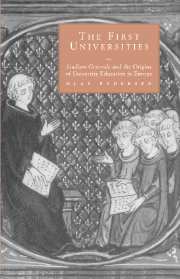Book contents
- Frontmatter
- Contents
- Preface
- Preface to the English edition
- List of abbreviations
- 1 The classical inheritance
- 2 From ancient science to monastic learning
- 3 The Carolingian Renaissance
- 4 The schools of the middle ages
- 5 From school to studium generale
- 6 The battle for the universities
- 7 Structure and form of government
- 8 The material situation
- 9 The road to degrees
- 10 Curricula and intellectual trends
- Index of names
4 - The schools of the middle ages
Published online by Cambridge University Press: 03 November 2009
- Frontmatter
- Contents
- Preface
- Preface to the English edition
- List of abbreviations
- 1 The classical inheritance
- 2 From ancient science to monastic learning
- 3 The Carolingian Renaissance
- 4 The schools of the middle ages
- 5 From school to studium generale
- 6 The battle for the universities
- 7 Structure and form of government
- 8 The material situation
- 9 The road to degrees
- 10 Curricula and intellectual trends
- Index of names
Summary
We have now reached that period in the history of Europe which immediately precedes the genesis of the university and which creates the concrete requirements for restructuring higher education. This space of time stretches from the tenth to the middle of the twelfth century and in many ways marks a turning point in the history of the middle ages. After the deep political and cultural drawback following the Carolingian period and the fearful expectation of the end of the world in the year 1000, a distinct age of prosperity set in. The middle ages now began to show their true colours in the development of a number of institutions and ideas, which in the political, economic, social, and spiritual spheres, built a new framework for human existence. As a background to the history of the medieval university, we must consider this framework a little more deeply; and even if this takes us rather far afield outside the history of learning in the narrow sense, the historical details in the following pages seem relevant for the understanding of the universities as the typical medieval institutions they were.
In general terms the most important political change is certainly to be found in the fact that Europe had at long last reached the end of the long period of invasions that began with the first migrations in the last days of the Roman empire, and ended with the last Viking raids. To the east the Hungarians were now settling down in their domain.
- Type
- Chapter
- Information
- The First UniversitiesStudium Generale and the Origins of University Education in Europe, pp. 92 - 121Publisher: Cambridge University PressPrint publication year: 1998
- 1
- Cited by



